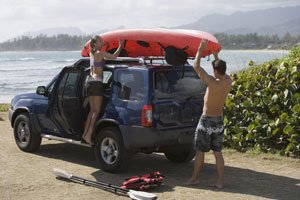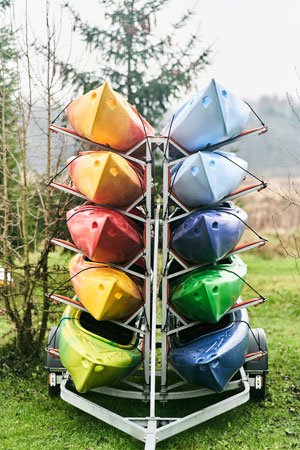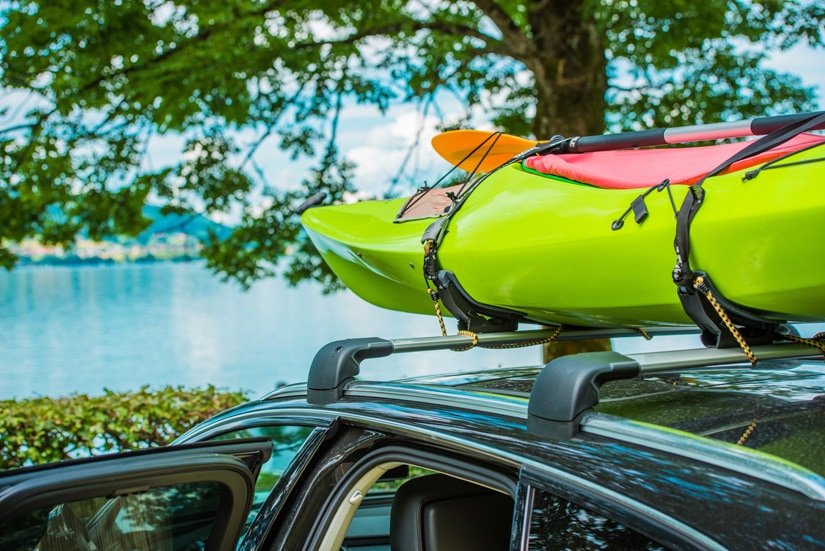Every kayaker looks forward to spending some time in the water. There is a lot to love such as whitewater excitement and the peace of recreational paddling. Others get to spend quality time with loved ones. Kayaking is one of those sports that you cannot get enough of.
But before you get to the fun part, you will face one hurdle—transporting the kayak. Moving your craft from your house to the water is difficult. It is even more frustrating if you don’t have a plan.
Anyway, you would be happy to know that you have several options. Some are affordable, others are not. The good thing is that they are all safe and convenient.
Key Takeaways
- There are several ways of transporting a kayak and you can choose depending on your vehicle, distance, and size of your kayak.
- Transporting a kayak on the roof of a car is common and you can either use a roof rack or carry your kayak without one.
- If you have a truck you can place your kayak in the truck bed. Just make sure you clean the truck bed and use padding.
- For bigger and heavier kayaks you can use a kayak trailer but this may not be an ideal option for long distances.
Transporting a Kayak on the Car Roof
This is probably the most common way of transporting kayaks and other small water crafts. Most boats can easily fit on the roof.
You can opt to either use a roof rack or mount the kayak without one.
a. Transporting a Kayak Using a Roof Rack

A roof rack allows you to carry your kayak using almost any type of car. Whether this method is safe or not depends on the size of your car—with smaller cars being less safe. Even with a big and appropriate car like an SUV, you still need to be careful. Know the weight limit of the rack and your car roof as well.
One benefit of roof racks is that some allow you to transport multiple kayaks. This way, you can use just one car for the whole family or a group of friends.
If your car came with a rack, you are lucky. If not, don’t worry; companies like Thule make outstanding racks for people like you.
In addition to a kayak roof rack, you need accessories like straps for tying down the kayak. Make sure you get those of the highest quality. They should also be in good condition.
Once you are sure everything is set:
- Fit the rack onto the roof of the car. You have to do this carefully and properly. To be on the safe side, when you go to buy a rack system, let the professionals install it.
- Stand at the back of your vehicle on one side and put your boat against it, rear side (stern) up. Lift the bow and slide your kayak onto the rack. This is for when you are alone. If you have someone else to help, let each person grab one end of the boat. Lift it on to the rack and slide it to the right position.
It is advisable to place the kayak bottom side up to avoid dents.
- Ensure that the kayak is placed well then use the straps to fasten it. Be a little gentle and avoid yanking. For added assurance, you can use ropes to tie the bow and stern to the rear and front bumper.
To transport two kayaks, you will need a roof rack and J-cradles/stackers. You can then load them on their edge, side by side. The cockpits should face opposite directions.
Note: for those with some money to spare, there are systems designed to help you load the kayak onto the roof. They make work easier and are also much safer.
b. How to Transport a Kayak Without a Roof Rack
This is cheaper than if you were to use a roof rack. It also works better if your car has four doors. There are things that you will have to buy. They include straps and two foam blocks or pool noodles.
The process is quite similar to using a roof rack.
- Take the pool noodles or foam blocks and place them at the front and back of your car’s roof. (You can get more pool noodles/foam blocks depending on how much padding you want).
- Lift the kayak and place it on the padding upside down. Adjust the blocks to be perpendicular to the length of the craft.
- Using the straps, tie down the boat. The first strap should go over the kayak with both ends meeting inside your car through the front doors. Do the same with the other strap and have its ends meet through the back doors. You can tie the bow and stern to the rear and front bumpers for added safety.
Don’t yank the straps while tying and don’t make them too tight.
Transporting a Kayak in a Truck Bed

While using a truck may seem like an easier option, you still have to follow the correct procedure. You will also need a few things: some kind of padding for the truck bed, straps and a truck bed extender (for longer kayaks)
- Clear all junk from your truck bed. You don’t want to place your kayak on sharp or rough objects. Besides getting damaged, it could get dirty. You also want to have as much space as possible and load the yak without obstacles.
- Put the padding in place. Although kayaks are made of durable material, they can still get damaged. That is why padding is important.
- When you are done, lower the tailgate.
- Get your kayak and slide it onto the truck bed. The stern should go in first. Place it diagonally, corner to corner.
- Depending on the length of the craft, you may not be able to close the tailgate—which is okay. It is better not to close it than to close it and lean the bow against it.
In some cases, the boat will extend past the tailgate. If that happens, you must use a truck bed extender to avoid breaking laws. Driving around with a hanging bow could be dangerous for other road users.
- After properly setting the kayak, it is time to strap it down. This is not hard because most trucks have points to which you can tie down the kayak. Alternatively, buy some yourself and install them.
- If you were unable to close the tailgate because of your yak’s length, attach red flags at the back. This notifies other road users of the load.
Transporting a Kayak with a Trailer

Trailers are another good option for transporting kayaks. You don’t have to struggle to lift a boat onto the roof of your car. Another thing, trailers have a higher weight limit compared to roof racks.
For long-distance traveling, however, they may end up becoming more of a nuisance. You have to be cautious everywhere, especially when parking and backing up. There is also the issue of registration where you will have to incur extra costs.
Other than these downsides above, a kayak trailer is great. Most of them will even have extra room for you to put your gear and any other accessories. Additionally, loading a boat onto a trailer is pretty straightforward.
Getting Your Kayak from the Car to the Water
This area may be an issue for some kayakers (mostly beginners). But you will be surprised at how easy it is.
If you have a friend, each person can grab either side. Kayaks usually come with grab handles.
For a solo paddler, hold the kayak by one of its side grab handles. It will be hanging on your side like a bag. This is for light crafts. You may also lift it to your shoulder by the cockpit rim.
Sometimes, the kayak is just too heavy for the above carrying methods. That is why they make kayak carts. These are convenient and you can comfortably carry your paddle and other gear.
The trouble of transporting a kayak is nothing compared to the joy of kayaking. Besides, you can simplify the process. Depending on the type of car you have, choose one method from above. The distance from your house to the water also matters. Next, buy the necessary accessories and follow the simple steps. It is as easy as that!

